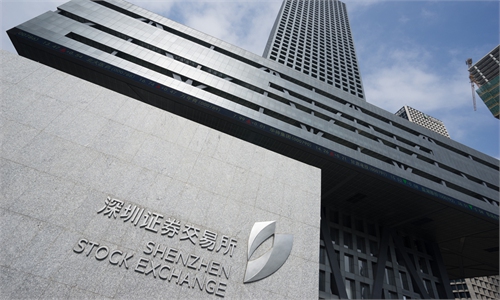Shanghai index guards supporting level of 3,000 points following 'the worst day of US stock this year' after Fed interest rate hike

A trader works on the floor of the New York Stock Exchange (NYSE) in New York, the United States, May 5, 2022. U.S. stocks plunged on Thursday as heavy selling intensified on Wall Street. The Dow Jones Industrial Average tumbled 1063.09 points, or 3.12 percent, to 32,997.97. The S&P 500 fell 153.30 points, or 3.56 percent, to 4,146.87. The Nasdaq Composite Index shed 647.17 points, or 4.99 percent, to 12,317.69. Photo: Xinhua
China's mainland stock market slipped on Friday, with benchmark Shanghai index once diving below 3,000 points and closing slightly higher than the psychological level at 3,001.56 points. All main share indexes slumped by more than 1 percent, as investors were rattled by the worst day of US stock this year on Thursday — one day after Federal Reserve's interest rate hikes which triggered delayed concern over US soaring inflation and its contracting economy.
The benchmark Shanghai Composite Stock Index dropped 2.16 percent, while the Shenzhen Component Index and the tech heavy ChiNext index also plunged by 2.14 percent and 1.950 percent, respectively.
Over 3,300 mainland stocks fell on Friday, and the daily transaction volume in Shanghai and Shenzhen stock bourses shrank by 141.2 billion to 759.8 billion yuan compared with the daily transaction on Thursday.
The Shanghai index had once dipped below 3,000 points on April 25 amid anxieties from epidemic flare-ups in several Chinese cities. The supporting line was recovered on April 29.
Stocks in airports and shipping, travel, property, and duty-free shopping experienced the biggest slumps, while self-developed software, medicine for the treatment of COVID-19 and internet e-commerce related shares led the gains.
Medicine-related stocks have been in a rally since the market reopened on Thursday, after the five-day May Day holiday breaks. China's top leadership also stressed at a meeting of the Standing Committee of the Political Bureau of the CPC Central Committee on Thursday that sticking to zero-COVID policy, indicating a massive market for nucleic acid test suppliers.
Analysts suggested the fluctuations in A-share market could last a couple of days, hovering around 3,000 points, as external sentiment weighed on and global markets were dragged by mounting worries over Fed's moves to contain inflation and wider concerns on the US economy.
"There will be a see-sawing battle around the Shanghai index of 3,000 points. And it is important for investors to stay condiment and patient, as such valuation is relatively low and will be bottomed out in the long term," Yang Delong, chief economist at Shenzhen-based First Seafront Fund Management Co, told the Global Times on Friday.
On Thursday, the Nasdaq Composite shed 4.99 percent, its biggest single-day plunge since June 2020, and touched down to close at its lowest level since November 2020. The Dow Jones Industrial Average and the S&P 500both fell more than 3 percent. That also erased the gains from Wednesday, when stock markets recorded their biggest one-day gain since 2020 after Fed chair Jerome Powell signaled earlier the same day not considering interest rates by 0.75 percentage points.
But as the COVID-19 situation in Shanghai stabilizes and the epidemic in Beijing comes under effective control, the market sentiment will gradually be restored and in the long term, the A-share market will operate stably, analysts stressed.
"The pledges from Chinese leadership and a ratchet of policy support in recent weeks would also help quell market sentiment," Yang said.
Amid US interest rate hike and economic downward pressure, the offshore yuan weakened past 6.7 per dollar to an 18-month low on Friday morning.
Global Times

